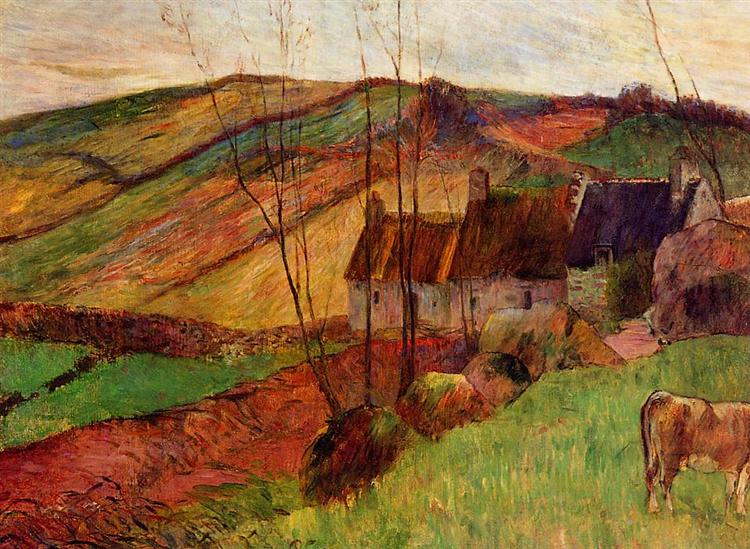Beschrijving
Het werk "cabañas op de berg Sainte Marguerite" van Paul Gauguin, geschilderd in 1888, is een prachtig voorbeeld van zijn karakteristieke stijl in het post -impressionistische stadium, waarin hij weggaat van de naturalistische weergave om levendige kleuren en symbolisch en emotioneel te verkennen composities. In dit schilderij roept Gauguin een landelijk landschap op dat, hoewel eenvoudig in het thema, wordt geladen met een voelbare zintuiglijke.
Het werk presenteert een complex kleurbeheer, waarbij warme en koude tonen met elkaar verweven zijn om een helderheidseffect te creëren dat de kijker uitnodigt om zich onder te dompelen in het landschap. De hutten, met hun lage daken en bijna primaire vormen, zijn gerangschikt in een natuurlijke omgeving die levend lijkt te trillen. Het kleurenpalet is opmerkelijk rijk; De green van de bomen en het gras contrasteren met de roze en oker van de gebouwen, waardoor een sfeer van rust en harmonie ontstaat. Dit gebruik van kleur bevordert niet alleen de identificatie van de elementen in het werk, maar brengt ook een bijna voelbare emotie over die resoneert met de zoektocht naar de kunstenaar voor de uitdrukking in plaats van door trouwe representatie.
De samenstelling van het schilderij is ingenieus. De hutten stemmen opzichtig aan en leidt de blik van de kijker naar het midden van het werk, waar ze lijken te stromen de bochtige wegen die het landschap oversteken. De achtergrond, met zijn ongrijpbare horizon en de zachte contouren van de bergen, aanvult en verheft de eenvoud van de hutten, waardoor het tafereel met extra diepte wordt begonnen. De keuze van hoeken en het ritme van vormen genereert een gevoel van sereniteit, waardoor de vrede die de kunstenaar waarschijnlijk in deze omgeving heeft gevonden, oproept.
Hoewel er geen zichtbare menselijke figuren zijn bij het schilderen, suggereert de weergave van de hutten een interactie met de menselijke omgeving die essentieel is voor de betekenis van het werk. De hutten, als elementen die zich voordoen in een landschap, spreken over de mens en hun relatie met de natuur, een terugkerend thema in het werk van Gauguin. Deze link reikt verder dan het eenvoudige coëxistentie en nodigt reflectie uit op de toevluchtsoord en de zoektocht naar de primitieve en de essentiële in een steeds geïndustrialiseerde wereld.
Gauguin, een pionier van symboliek en het expressieve gebruik van kleur, voedde zijn ervaringen in Bretagne en Tahiti om de beperkingen van het impressionisme te overstijgen. Zijn verlangen om de spirituele essentie van het leven vast te leggen, vertaalt zich in werken zoals deze, die, hoewel blijkbaar eenvoudig, een complexiteit van metingen biedt die kan worden onderzocht via de landschapslagen en de tonen die u kiest. "Cabañas op Mount Sainte Marguerite" is daarom meer dan een portret van een plaats: het is een meditatie over de verbinding van de mens met zijn natuurlijke omgeving, een echo van de constante zoektocht naar het sublieme in het dagelijks leven.
Deze Gauguin -benadering, beïnvloed door zijn interesse in cultuur en symboliek, plaatst het in een continuïteitslijn met andere post -impressionistische kunstenaars die emotie hebben onderzocht door vorm en kleur. Zijn werk in dit schilderij kan worden gezien als een voorloper van daaropvolgende artistieke bewegingen die erop stonden op het belang van subjectieve expressie, een element dat sterk werd gedefinieerd in het artistieke oordeel van de volgende generaties. Dit werk is dus niet alleen een getuigenis van de technische beheersing van Gauguin, maar ook een uitnodiging om te mediteren over onze plaats in de natuurlijke wereld.
KUADROS ©, een beroemde verf op je muur.
Handgemaakte olieverfschilderijen, met de kwaliteit van professionele kunstenaars en de onderscheidende afdichting van KUADROS ©.
Foto's Reproductieservice met tevredenheidsgarantie. Als u niet helemaal tevreden bent met de replica van uw schilderij, betalen wij uw geld 100%terug.

